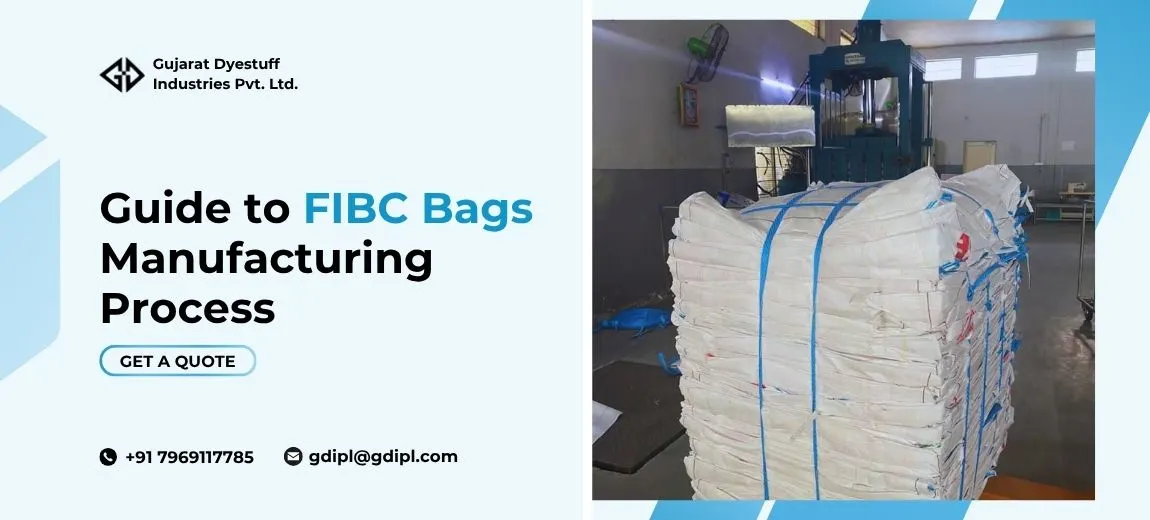Guide to FIBC Bags Manufacturing Process
Views : 1201

There is a huge need around the world for packaging that is robust, flexible, and affordable. FIBC bags are becoming the most popular alternative for businesses all over the world. These big containers make it easier to store and move enormous amounts of anything safely, from chemicals and agriculture to drugs and construction.
But have you ever thought about how these strong bulk bags are made? This in-depth article will show you how FIBC bags are made, what affects the pricing of FIBC bags, and why working with an experienced manufacturer like GDIPL, which has been in the business for over 43+ years, is the best choice for your business.
What Are FIBC Bags?
Flexible Intermediate Bulk Container (FIBC). These bags are big, strong, and light. They are normally constructed of woven Polypropylene(PP) fabric. Their main job is to hold and move large amounts of dry, flowable goods like grains, sand, fertilisers, chemicals, or even food-grade ingredients.
An FIBC container can carry between 500 kg and 2,000 kg of material, depending on what you need. The bags come in a variety of shapes and styles, such as:
- U-Panel Bags - great for carrying hefty things.
- Circular Bags - Made from tubular fabric that is strong all the way around.
- Baffle Bags - made to hold their shape better while being filled.
Why the Quality of Manufacturing Is Important
The reliability of an FIBC container largely relies on its quality and precision in manufacturing. In competitive markets, you cannot risk having a poorly made bag, as it may lead to spills, safety concerns, or contamination. This is why collaborating with a reputable company like GDIPL is essential, which ensures that each bag meets strict international quality standards.
How to Manufacture FIBC Bags
A Comprehensive Instruction Manual Here’s a look into the processes involved in FIBC bag creation:
1. Raw Material Selection:
Selecting appropriate raw materials The initial step is to obtain premium Polypropylene (PP) granules, which serve as the primary fundamental component GDIPL exclusively uses the best materials to make sure that each FIBC container works better than the rest.
Through an extrusion process, the Polypropylene (PP) granules are melted and turned into tapes or filaments. After that, the tapes are stretched to make them stronger. This step is very important because strong tapes make strong cloth.
3. Making the fabric
Using either circular or flat weaving machines, the stretched tapes are turned into fabric. The bag's load capacity, breathability, and durability are all affected by the weave density. Extra coatings or liners may be added for certain uses, such as food-grade or dangerous compounds.
4. Cutting and printing
Once the fabric is finished, it is divided into sections that match the design of the required bag. At this stage, crucial details such as product usage, branding, and features are printed onto the fabric using premium inks that remain vivid and endure over time.
5. Putting things together and sewing them
This is where the bag starts to look like itself. Heavy-duty threads are used to sew the panels together, and other parts like lifting loops, intake and output spouts, or liners are added. Customisation is important here because different sectors have varied needs when it comes to filling, emptying, and lifting.
6. Testing for Quality
Every bag that leaves the plant has to undergo thorough quality testing. To make sure that each FIBC bag meets international requirements, they are put through load-bearing tests, safety factor checks, and visual inspections. GDIPL promises that every product goes through a strict inspection process to make sure it is as safe and reliable as possible.
Common Applications of FIBC Bags
| Industry | Application |
|---|---|
| Agriculture | Storing grains, seeds, and fertilisers. |
| Construction | Transporting sand, cement, and gravel. |
| Chemicals | Safe handling of powders and pellets. |
| Food Processing | Packaging sugar, flour, and food additives. |
Factors Influencing FIBC Price
One common question buyers have is: What determines the cost of a FIBC bag? Several factors influence FIBC price, including:
- Bag Size & Design – Bigger bags or complex designs require more material and effort.
- Fabric Quality – Higher GSM (grams per square metre) means stronger fabric, but at a slightly higher cost.
- Additional Features – Extra features like coatings, liners, anti-static qualities, or food-grade compliance can make the price go up.
- Quantity Ordered – When you order in bulk, you normally get better prices.
At GDIPL, we find the perfect mix between low prices and high quality, so you get the most for your money.
Why GDIPL is the Best Choice for FIBC Bags
GDIPL is a well-known company in the packaging business with decades of expertise. They make FIBC containers that are strong, safe, and affordable. This is what makes us different:
- Custom Solutions: We meet your specific needs from design to delivery.
- Competitive Prices: Get the best FIBC bags at the greatest prices.
- Strict QC: Every bag is checked to make sure it matches international standards.
GDIPL has the best packaging solutions for your business, whether you're a big factory or a small firm that is growing.
Conclusion
When businesses know how FIBC bags are made, they can choose the best bulk packaging options for their needs. Every stage, from choosing the right materials to doing the final tests, is very important for making sure that the product is safe, long-lasting, and cost-effective.
GDIPL is an industry leader with more than 43+ years of experience. If you want trustworthy, high-quality FIBC containers at low costs, trust them. Our commitment to innovation, quality, and customer satisfaction makes us your ideal partner in bulk packaging.
Contact GDIPL today to explore our wide range of FIBC solutions and get the best FIBC price for your requirements.

